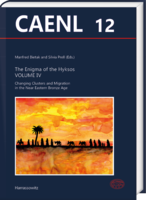|
weitere Titel zum Thema:
The volume comprises the collected papers of a workshop titled ‘Changing Clusters and Migration in the Near Eastern Bronze Age’ (Vienna, December 2019), organised by the ERC Advanced Grant ‘The Enigma of the Hyksos’.
During the second half of the 12th Dynasty, Egypt confronted an influx of foreigners settling in the Eastern Nile Delta. Potentially linked to this migration was the subsequent ad interim rule of two foreign dynasties (14th and 15th Dynasties) over Northern Egypt. Information about the exact origin of the Near Easterners responsible for the rise of Hyksos rule is sparse and several questions regarding the Hyksos and their predecessors still require further investigation, including: their exact geographical origin, the degree of their cultural and ethnic homogeneity, the reasons for their migration to Egypt, the means by which they assumed political control and the extent to which they maintained ties to their places of origin. For these questions to be explored, several multi-disciplinary analyses ensued from various contexts across Mesopotamia, the Levant, and Egypt prior to and during the so-called Hyksos Period. These include material cultural analyses, anthropological, cultural interference and migration studies, the analysis of settlement patterns and architecture, new onomastic studies, a new historiographical approach, and bioarchaeological analyses of physical remains. The variety of material now available, and so far, largely neglected in the scientific discussion, can finally be utilised as first rate historical resources. |






